2020/December Latest Braindump2go AI-900 Exam Dumps with PDF and VCE Free Updated Today! Following are some new AI-900 Real Exam Questions!
QUESTION 42
You need to reduce the load on telephone operators by implementing a chatbot to answer simple questions with predefined answers.
Which two AI service should you use to achieve the goal? Each correct answer presents part of the solution.
NOTE: Each correct selection is worth one point.
A. Text Analytics
B. QnA Maker
C. Azure Bot Service
D. Translator Text
Answer: BC
Explanation:
Bots are a popular way to provide support through multiple communication channels. You can use the QnA Maker service and Azure Bot Service to create a bot that answers user questions.
Reference:
https://docs.microsoft.com/en-us/learn/modules/build-faq-chatbot-qna-maker-azure-bot-service/
QUESTION 43
Which two scenarios are examples of a conversational AI workload? Each correct answer presents a complete solution.
NOTE: Each correct selection is worth one point.
A. a smart device in the home that responds to questions such as “What will the weather be like today?”
B. a website that uses a knowledge base to interactively respond to users’ questions
C. assembly line machinery that autonomously inserts headlamps into cars
D. monitoring the temperature of machinery to turn on a fan when the temperature reaches a specific threshold
Answer: AB
QUESTION 44
You have the process shown in the following exhibit.

Which type AI solution is shown in the diagram?
A. a sentiment analysis solution
B. a chatbot
C. a machine learning model
D. a computer vision application
Answer: B
QUESTION 45
You need to develop a web-based AI solution for a customer support system. Users must be able to interact with a web app that will guide them to the best resource or answer.
Which service should you use?
A. Custom Vision
B. QnA Maker
C. Translator Text
D. Face
Answer: B
Explanation:
QnA Maker is a cloud-based API service that lets you create a conversational question-and-answer layer over your existing data. Use it to build a knowledge base by extracting questions and answers from your semi-structured content, including FAQs, manuals, and documents. Answer users’ questions with the best answers from the QnAs in your knowledge base–automatically. Your knowledge base gets smarter, too, as it continually learns from user behavior.
Incorrect Answers:
A: Azure Custom Vision is a cognitive service that lets you build, deploy, and improve your own image classifiers. An image classifier is an AI service that applies labels (which represent classes) to images, according to their visual characteristics. Unlike the Computer Vision service, Custom Vision allows you to specify the labels to apply.
D: Azure Cognitive Services Face Detection API: At a minimum, each detected face corresponds to a faceRectangle field in the response. This set of pixel coordinates for the left, top, width, and height mark the located face. Using these coordinates, you can get the location of the face and its size. In the API
response, faces are listed in size order from largest to smallest.
Reference:
https://azure.microsoft.com/en-us/services/cognitive-services/qna-maker/
QUESTION 46
Which AI service should you use to create a bot from a frequently asked questions (FAQ) document?
A. QnA Maker
B. Language Understanding (LUIS)
C. Text Analytics
D. Speech
Answer: A
QUESTION 47
Which scenario is an example of a webchat bot?
A. Determine whether reviews entered on a website for a concert are positive or negative, and then add a thumbs up or thumbs down emoji to the reviews.
B. Translate into English questions entered by customers at a kiosk so that the appropriate person can call the customers back.
C. Accept questions through email, and then route the email messages to the correct person based on the content of the message.
D. From a website interface, answer common questions about scheduled events and ticket purchases for a music festival.
Answer: D
QUESTION 48
What is a Use Case for classification?
A. Paleontologist collecting bone samples and grouping them that have a similar structure resembling fossils.
B. Predicting if someone will walk to office from home based on the outside weather and the distance between the office and home.
C. Predicting the shelf life of a cookie-based on the oven temperature where the cookie was baked.
D. Predicting how many minutes a flight will be delayed based on weather data.
Answer: B
QUESTION 49
Which machine learning algorithm is mostly used for predicting the values of categorical variables.
A. K-Means
B. Logistic regression
C. Linear regression
Answer: C
QUESTION 50
You own a service desk company and employs a team of customer service agents to provide telephone and email support to customers.
Now you are planning to develop a web chatbot to automatically answer common customer queries. What business benefit the does owner expect as a result of the web chatbot?
A. Increase sales
B. Reduced workload for the customer service agents
C. Improve product reliability
Answer: B
QUESTION 51
________________ is the average of absolute differences between prediction and actual observation where all individual differences have equal weight.
Select the appropriate regression performance metrics from below to complete the sentence.
A. Coefficient of Determination (R2)
B. Relative Squared Error (RSE)
C. Relative Absolute Error (RAE)
D. Mean Absolute Error (MAE)
Answer: D
QUESTION 52
You are working as a cloud consultant for a major retail company. You are planning to create a bot from a frequently asked questions (FAQ) document. You found out that Microsoft Azure AI has many services that can help in creating a bot seamlessly.
Which azure AI service should you use?
A. QnA Maker
B. Language understanding
C. Speech
D. Text analysis
Answer: A
QUESTION 53
To complete the following sentence, select the appropriate option from the drop-down menu.
________________ is a process in which the best machine learning algorithm to use for your specific data is selected for you.
A. Automated machine learning (AutoML)
B. Normalization
C. Feature engineering
Answer: A
Explanation:
AutoML is a process in which the best machine learning algorithm to use for your specific data is selected for you. AutoML tries different algorithms and tuning parameters in parallel while training a model and stops once it reaches predefined exit criteria. Generated output provides the list of used algorithms along with recommendations on the best ones to use.
Normalization is a technique used to change the values in numeric columns to bring them up to the common scale; to the values ranging between 0 and 1, without loss of information or differences in the value ranges.
Feature engineering is a process of creating new features from within provided input dataset, which can help to better represent relationships and correlations between the input data and expected outcome.
Feature engineering improves the quality and performance of the trained model and increases its predictive power.
QUESTION 54
Which two of these sources can you translate from one language into another? Each correct answer presents a complete solution. Choose the correct answers
A. Text
B. Speech
C. Image
D. Video
E. Handwriting
Answer: AB
Explanation:
Text translation translates the text documents from one language into another language.
Speech translation translates spoken audio from one language into another language.
Converting handwriting to text is an example of Optical character recognition (OCR). OCR extracts handwritten text from an image. You can use text translation with the output from OCR.
Extracting the text in an image is also an example of Optical character recognition (OCR). OCR can recognize individual shapes as letters, numerals, punctuation, and other elements of text. OCR extracts the recognizable text from an image. You can use text translation with the output from OCR.
Videos can be analyzed and the spoken audio transcribed into text with media services. You can use text translation with the output from media services.
QUESTION 55
Hotspot Question
For each of the following statements, select Yes if the statement is true. Otherwise, select No.

Answer:

Explanation:
The Transparency principle does not deal with fairness. It indicates that Al systems should be understandable. System users should have a clear understanding of how an Al system operates, what data it utilizes, what the system’s capabilities and limitations are, and so on. The guiding principle concerned with Al systems treating all people fairly is Fairness.
The Reliability & Safety principle indicates that Al systems should perform reliably and safely. This requires proper testing and verification of an Al system’s functionality to ensure that it works as expected and to eliminate potential risk to human life. The guiding principle concerned with Al systems being secure and respecting privacy is Privacy & Security.
People should be accountable for Al systems according to the Accountability principle. Al systems are built by people (designers and developers) and they should be responsible for what Al systems do. It requires people to follow governance and organizational policies to ensure that the solution meets clearly defined ethical and legal standards.
QUESTION 56
Drag and Drop Question
Match the computer vision type to the scenario. To answer, drag the appropriate type to each scenario. A type may be used once, more than once, or not at all.

Answer:

Explanation:
Face detection can be used to monitor a driver’s face. The angle of the head can be determined and used to tell if the driver is looking at the road ahead, or looking down at a mobile device, or if the driver is showing signs of tiredness.
Image classification can be used to evaluate scanned images from MRI machines to classify the images against trained images of known medical conditions.
Object detection can be used to detect objects in an image. You can train Computer Vision to detect face masks. Face detection does not include the ability to recognize that a face is covered with a mask. Masks may actually prevent faces from being recognized.
Optical character recognition (OCR) extracts text from an image. OCR can recognize individual shapes as letters, numerals, punctuation, and other elements of text.
QUESTION 57
Hotspot Question
For each of the following statements, select Yes if the statement is true. Otherwise, select No.

Answer:

Explanation:
A bot created with the Azure Bot Framework SDK can be integrated with LUIS. You can add LUIS to your bot when you create the bot, or add LUIS later. You use the Dispatch tool to route messages from the bot to LUIS.
A bot created with the Azure Bot Framework SDK can be integrated with QnA Maker knowledge bases. You use the Dispatch tool to route messages from the bot to QnA Maker. Your bot can choose which has the best response for the user.
A bot created with the Azure Bot Framework SDK can be integrated with bots created using Power Virtual Agents. You use the Dispatch tool to configure your bot to work with a Power Virtual Agent bot.
QUESTION 58
Hotspot Question
You are developing a model to predict events by using classification.
You have a confusion matrix for the model scored on test data as shown in the following exhibit.

Use the drop-down menus to select the answer choice that completes each statement based on the information presented in the graphic.
NOTE: Each correct selection is worth one point.

Answer:
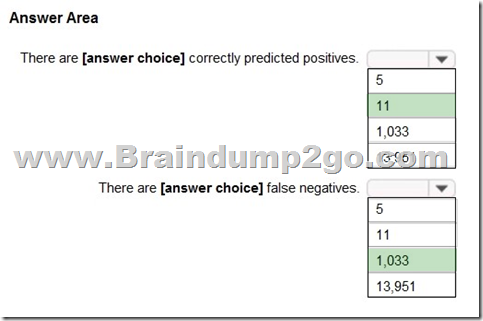
Explanation:
Box 1: 11
TP = True Positive.
The class labels in the training set can take on only two possible values, which we usually refer to as positive or negative. The positive and negative instances that a classifier predicts correctly are called true positives (TP) and true negatives (TN), respectively. Similarly, the incorrectly classified instances are called false positives (FP) and false negatives (FN).
Box 2: 1,033
FN = False Negative
Reference:
https://docs.microsoft.com/en-us/azure/machine-learning/studio/evaluate-model-performance
QUESTION 59
Hotspot Question
For each of the following statements, select Yes if the statement is true. Otherwise, select No.
NOTE: Each correct selection is worth one point.

Answer:

Explanation:
Anomaly detection encompasses many important tasks in machine learning:
Identifying transactions that are potentially fraudulent. Learning patterns that indicate that a network intrusion has occurred.
Finding abnormal clusters of patients.
Checking values entered into a system.
Reference:
https://docs.microsoft.com/en-us/azure/machine-learning/studio-module-reference/anomaly-detection
QUESTION 60
Hotspot Question
To complete the sentence, select the appropriate option in the answer area.
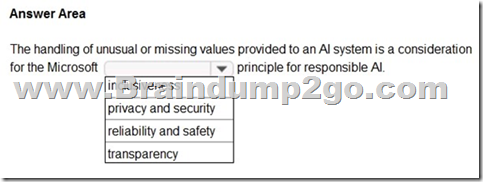
Answer:
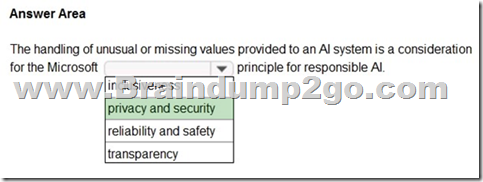
Explanation:
Privacy and security.
As AI becomes more prevalent, protecting privacy and securing important personal and business information is becoming more critical and complex. With AI, privacy and data security issues require especially close attention because access to data is essential for AI systems to make accurate and informed predictions and decisions about people. AI systems must comply with privacy laws that require transparency about the collection, use, and storage of data and mandate that consumers have appropriate controls to choose how their data is used. At Microsoft, we are continuing to research privacy and security breakthroughs (see next unit) and invest in robust compliance processes to ensure that data collected and used by our AI systems is handled responsibly.
Reference:
https://docs.microsoft.com/en-us/learn/modules/responsible-ai-principles/4-guiding-principles
QUESTION 61
Drag and Drop Question
Match the types of AI workloads to the appropriate scenarios.
To answer, drag the appropriate workload type from the column on the left to its scenario on the right. Each workload type may be used once, more than once, or not at all.
NOTE: Each correct selection is worth one point.
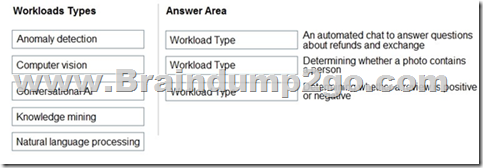
Answer:
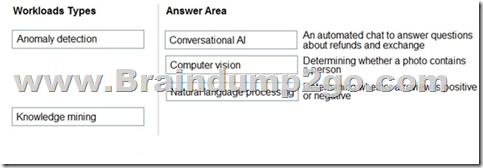
Explanation:
Box 3: Natural language processing
Natural language processing (NLP) is used for tasks such as sentiment analysis, topic detection, language detection, key phrase extraction, and document categorization.
Reference:
https://docs.microsoft.com/en-us/azure/architecture/data-guide/technology-choices/natural-language-processing
QUESTION 62
Drag and Drop Question
Match the Microsoft guiding principles for responsible AI to the appropriate descriptions.
To answer, drag the appropriate principle from the column on the left to its description on the right. Each principle may be used once, more than once, or not at all.
NOTE: Each correct selection is worth one point.
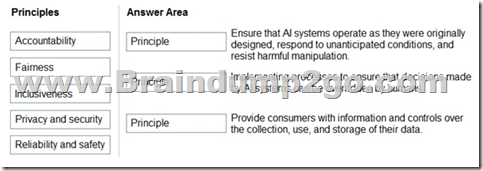
Answer:
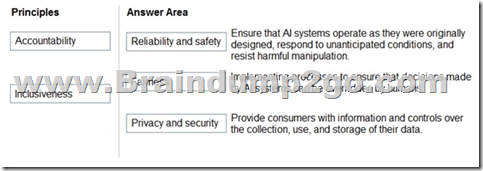
Explanation:
Box 1: Reliability and safety
To build trust, it’s critical that AI systems operate reliably, safely, and consistently under normal circumstances and in unexpected conditions. These systems should be able to operate as they were originally designed, respond safely to unanticipated conditions, and resist harmful manipulation.
Box 2: Fairness
Fairness: AI systems should treat everyone fairly and avoid affecting similarly situated groups of people in different ways. For example, when AI systems provide guidance on medical treatment, loan applications, or employment, they should make the same recommendations to everyone with similar symptoms, financial circumstances, or professional qualifications.
We believe that mitigating bias starts with people understanding the implications and limitations of AI predictions and recommendations. Ultimately, people should supplement AI decisions with sound human judgment and be held accountable for consequential decisions that affect others.
Box 3: Privacy and security
As AI becomes more prevalent, protecting privacy and securing important personal and business information is becoming more critical and complex. With AI, privacy and data security issues require especially close attention because access to data is essential for AI systems to make accurate and informed predictions and decisions about people. AI systems must comply with privacy laws that require transparency about the collection, use, and storage of data and mandate that consumers have appropriate controls to choose how their data is used
Reference:
https://docs.microsoft.com/en-us/learn/modules/responsible-ai-principles/4-guiding-principles
Resources From:
1.2020 Latest Braindump2go AI-900 Exam Dumps (PDF & VCE) Free Share:
https://www.braindump2go.com/ai-900.html
2.2020 Latest Braindump2go AI-900 PDF and AI-900 VCE Dumps Free Share:
https://drive.google.com/drive/folders/1VMADE4rTtp2SjgbY_rnCokxgjUS7cH28?usp=sharing
3.2020 Free Braindump2go AI-900 PDF Download:
https://www.braindump2go.com/free-online-pdf/AI-900-Dumps(31-41).pdf
https://www.braindump2go.com/free-online-pdf/AI-900-PDF(16-30).pdf
https://www.braindump2go.com/free-online-pdf/AI-900-PDF-Dumps(1-15).pdf
https://www.braindump2go.com/free-online-pdf/AI-900-VCE(55-66).pdf
https://www.braindump2go.com/free-online-pdf/AI-900-VCE-Dumps(42-54).pdf
Free Resources from Braindump2go,We Devoted to Helping You 100% Pass All Exams!